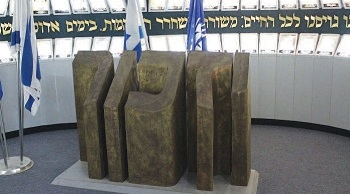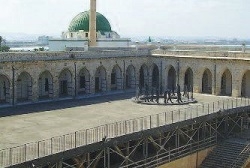Israel's Historical Museums
The International Council of Museums (ICOM) sets standards which are observed world-wide, and it has set rigorous definitions for what is to be considered an historical museum. Thus cultural museums or art museums are excluded from this genre.
In Israel, museums fall under the jurisdiction of the Ministry of Sports and Culture. Holocaust memorialization gave rise to a distinctly new type of historical museum, in which the historical subject was confined to a single topic or event.
Historically speaking, it was Mordechai Shenhavi who proposed the concept of collective commemoration of victims as early as 1942, and the Jewish Agency officially adopted the project in 1945, naming it Yad Vashem.
However, the present-day Yad Vashem did not become reality until 1953, and was preceded by two important facilities in 1949, just after the War of Independence.
The Ghetto Fighters' House Museum (GFH), founded in 1949, was one of the first two museums in Israel to address the Holocaust as a topical narrative. The year coincided with the State of Israel's first official act of designating a facility for Holocaust remembrance.
However, the first to open its doors was not GFH or Yad Vashem, as is widely believed, but Martef Ha'Shoah (The Holocaust Cellar). The task was assigned to the Ministry of Religion, who then appointed Dr. Rabbi Samuel Zanwil Kahane in charge, designating him as "in charge of Mount Zion", where the facility was and is located. Kahane served as the Director-General of the Ministry of Religious Affairs, between 1948 and 1971, on behalf of the National Religious Party. He was responsible for the development of various holy sites in the State of Israel, such as King David's Tomb on Mount Zion and Elijah's Cave in Haifa.
The Ghetto Fighters' Kibbutz was officially founded on Passover 1949, and during the dedication, a commemorative ceremony was held for the victims and survivors of the Warsaw Ghetto uprising, all heroes of this resistance.
Spontaneously, various members brought in random objects and memorabilia that they had managed to hold on to, and these were stored and displayed. Initial activities took place in a shack adjacent to the main commemoration facility and initially this was a "temporary improvised exhibition".
The building was somewhat remade and in 1951 it was dedicated as the museum building, though for years it was referred to as "The Shack".
With time, the GFH matured into a world-class museum and today functions as a respected teaching and research institution. Martef HaShoah saw its popularity greatly diminish after the 1967 recovery of the Kotel (Western Wall).
For a time, the epicenter of religious observance and festivals, it later receded into a spiritual focus of remembrance, mostly favored by a religiously observant and Ashkenazi oriented population and a small group of religious pilgrims from the destroyed communities in pre-war sites in Europe.
Today, the pre-eminent Holocaust museum in Israel, and for that matter worldwide, is Yad Vashem. It is far more than a museum and is an institution founded for the purpose of remembrance, as set forth in the August 19, 1953 Law of Yad Vashem.
The full purposes of Yad Vashem, as described by its mission statement on the institution's website – is to serve four pillars of Remembrance: Commemoration, Documentation, Research and Education. The current Chairman of the Directorate, Avner Shalev, has emphasized many times that the institution is not confined to its world-famous historical museum, but serves a multitude of functions, most notably the annual Yom Ha'Shoah observation.
Finally we have a series of museums centered on wars, military actions and/or battles, along with military establishments and, as is the case of two jails, for Jewish freedom-fighters during British-ruled Mandated Palestine. All told, there are fourteen such museums, operated by the Ministry of Defense (MOD), and sometimes referred to as the IDF museums.
The Ministry of Defense (MOD) museums have a logical rhetoric, rooted in the administrative structure. Directed by a central administration, they comprise the following museums:
■Eliyahu Golomb Haganah Museum, Tel Aviv
■Amihai Palgin IZL ("Irgun") Museum, Tel Aviv
■Yair Stern Lehi ("Stern Group") Museum, Tel Aviv
■An archival repository, Tel Aviv
■Hebrew Battalions House, Moshav Avihaiyil
■Haapala (Clandestine Immigration)
■Navy Museum, Haifa
■Ha'Shomer Museum, Kefar Gil'adi
The basic ideology and common background of this group of museums stems from the mid 1950's, when a group of military leaders – both serving and retired – began to discuss the necessity of bringing military history into the sphere of public visibility.
While the idea of an IDF museum was already under discussion but not advancing, they made plans for a series of museums, which were was built around historical scenarios seen as fundamental to the advancement of the Yishuv (pre-state settlement), and later to the formation of the State of Israel. Thus they are grouped within an historical framework by dating periods chronologically.
Aimed at commemorating the early periods of the Yishuv, from 1909 to 1920, are the Ha'Shomer (Watch-Keepers) Museum and the Hagdud Ha'Nevi'im (Hebrew Legions) Museum. Ha'Shomer activists became, in later years, the Haganah, which progressed into the formation of the IDF.
The "Undergrounds" refer to the group of museums focused on resistance activism under British rule. They include the Stern Museum, the Lehi Museum and the Palmach Museum.
It took several years for the resistance organizations who lent their names to these museums, to settle their acrimony and historic differences and to create an atmosphere of co-existence, even if this was to be only for memorialization.
The museums are thematically date-stamped along a timeline, commencing in 1920 and extending until Independence in 1948. The two Underground Prisoner Museums, or as named, Asirei Ha'Machtatot, are found in Akko and Jerusalem. The Etzel Museum in Tel Aviv is viewed as bordering on the 1948 time divide.
In addition, we have the Irgun Museum, the Hebrew Battalions House Museum in Moshav Avihayil and the Navy Museum, on the outskirts of Haifa. Named the Clandestine Immigration and Naval Museum, the narrative describes two aspects of maritime history, from illegal immigration [clandestine immigration or, in Hebrew, Ha'apalah] and a rag-tag collection of privately procured ships, intended to represent the history of the Israel Navy, complete with an actual missile boat, INS Mivtach and the INS Gal, a retired submarine.
The IDF history museum, located in Tel Aviv, is a latecomer to Israel's military museum hierarchy. While the concept was first proposed, indeed ordered, by Ben-Gurion in the 1950s, the only part of his order that was followed faithfully was the collection of all things related to Israeli military history and the IDF.
Over a period of years after these orders were given, a huge amount of material went into storage and lay languishing. Thus when the Beit Ha'Osef IDF, as it is known in Israel, opened its doors in 1999, it seemingly regurgitated the contents of all that was accumulated and this explains why it is also known as the Collections House Museum.
It has been critiqued for being poorly organized and lacking proper curatorial oversight. Here, it would be far too ambitious to venture into an in-depth discussion of each of these institutions.
The Atlit Detention Center museum complex occupies nearly 25 acres, and is situated along-side the entire original campsite. An array of buildings houses artifacts collections, documenting the harsh life endured by the immigrating Jews.
The entrance to the large "reception center" used by the British soldiers, has the delousing shower at its entrance, just as it was in its originally functioning state, and it serves as a stark reminder of the horrors endured by Jews who, after liberation, were once again faced with a shower, the symbolic killing-apparatus of the Holocaust.
The site of the Atlit complex adds an additional dimension, which under ICOM classifications is considered a heritage site. Revisiting some of the previously discussed institutions, we should note that GFH and Martef Ha'Shoah are also situated along historical landscapes and thus transform and elevate the "museum experience" into the realm of memory-scape.
As a total experience, visiting these historical institutions delivers a strong message about who we are and where we came from.










Comments